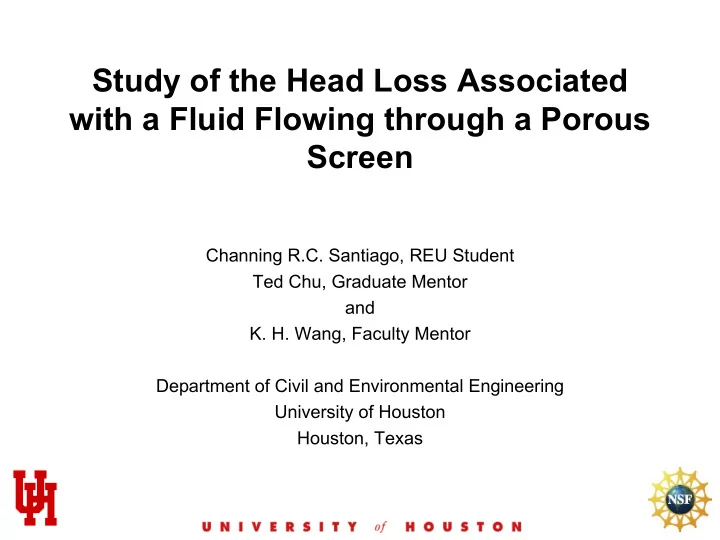

Study of the Head Loss Associated with a Fluid Flowing through a Porous Screen Channing R.C. Santiago, REU Student Ted Chu, Graduate Mentor and K. H. Wang, Faculty Mentor Department of Civil and Environmental Engineering University of Houston Houston, Texas
Common Applications of Screens • Fish Screens • Removal of Debris • Capture Solid Waste All these screens have a common goal in terms of head loss.
Possible Applications • Wave Energy Dissipation Coastal Structures Ship Channels
THEORETICAL BACKGROUND
Head Loss (ΔH) Screen Flow • energy loss Y 1 Y 2 θ Energy Equation
Porosity (ø) • The ratio of the open area of the screen to the total area. Round – 60º Staggered Center
Normal Velocity Continuity Equation Screen V 1 S L Y 1 Other Identities: V n 1) θ 2)
Darcy’s Law L Q b a A • Describes a flow through a porous medium • k: Intrinsic Permeability • ν(nu): Kinematic Viscosity
Equation Proposed by Forchheimer • Darcy’s law is not valid for all flows through porous media Darcy flow Non-Darcy flow
Reynolds Number • Used to locate the point at which the flow switches from Darcy to non-Darcy
Experiments
The Hydraulic Lab
Screens 1/4” Diameter Holes 1/8” Diameter Holes Ø = 0.4031
Screens 3/32” Diameter Holes 1/16” Diameter Holes Ø = 0.2267
Screen Brace
Profile of Flow Through Screen 90º 75º 68º 59º
Flow Rates (Q) 1/4” and 1/8” screens (ø = 0.4031) • 0.10, 0.20-2.20 (cfs) 3/32” and 1/16” screens (ø = 0.2267) • 0.10, 0.20-1.60 (cfs)
Results
General Trend • Decreasing flow rate = decrease in ΔH • Decreasing angle of inclination = decrease in ΔH
Formulating an Equation (ΔH is proportional to V^2/2g ?)
Formulating an Equation • Next, we plot ΔH vs. V^2/2g Angle of inclination is not considered.
Formulating an Equation Plot of ΔH vs. (V 1 sinθ)^2/2g A transition in the plot.
Formulating an Equation
Formulating an Equation: ø = 0.4031 1 st Half Function is x 1/2 Forchheimer’s Equation Darcy flow
Formulating an Equation: ø = 0.4031 2 nd Half • Function is linear • Forchheimer’s Equation Non-Darcy flow
Formulating an Equation: ø = 0.2267 • Function is linear 1 st Half Darcy flow
Formulating an Equation: ø = 0.2267 2 nd Half ???
Critical Reynolds Number Ø = 0.4031 Ø = 0.2267
Conclusions • General Trend • Porosity is More of a Factor than Pore Size • No Apparent Trend with Critical Reynolds Number • More Testing is Needed
Recommend
More recommend